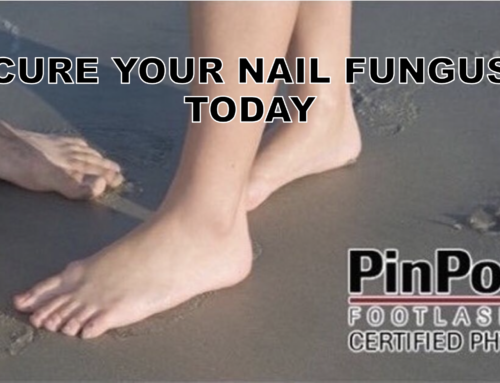How common is toenail fungus? About 10% of the general population suffers from toenail fungus. It is more common in older adults where 20% of people over the age of 60 and 50% of people over 70 are affected. Why is it so common and how do we get it?
Toenail Fungus Infection
Fungal nail infection or Onychomycosis causes the nail to appear yellowish, brown, green, black, or white. Besides discoloration, the affected nail can also become thickened and brittle. In severe cases, the nail can break apart or fall off.
This condition can be very difficult to treat, and it does not go away on its own. The fungus can spread to other parts of the foot or even the body. It can be mild with cosmetic implications, or it can cause pain and discomfort. Because of the changes in the nail’s appearance, it can be a source of embarrassment.
Fungal nail infections are caused by different types of fungi, molds, and yeasts. The fungus affects the toenails more than the fingernails because the toes are usually in a closed environment. Furthermore, toenails grow slower and often have poor hygiene.
Who gets infected?
People at risk of fungal infections are those with diabetes or who have poor blood circulation to the extremities. People with compromised immune systems like those with HIV or cancer are also at risk of nail fungus because their bodies are not strong enough to fight off the overgrowth of fungi. Fungi are prevalent in sweaty shoes, swimming pools, communal showers, and public toilets. They thrive in dark and damp areas and can remain viable for months.
The fungal spores can easily be picked up by walking barefoot in high-risk areas. Wet shoes and socks can also harbor these microorganisms. Wearing improper footwear can cause trauma to the nails making it easy for the fungus to invade and cause an infection.
Medically known as Onychomycosis, Toenail Fungus can be embarrassing, irritating, and in some cases, painful. Also, dealing with toenail fungus is extremely difficult. It can be a result of trauma where the nail lifts from the nailbed and allows fungal spores to infect the area. If not treated, the fungus grows and spreads. The fungus thrives in dark, warm, and moist environments like sweaty socks and shoes.
Symptoms of Toenail Fungus include:
- Yellow or brown discoloration of the nail
- Deformed nails
- Thickening of the nail
- Brittle or crumbling nails
- Streaks or spots on the nail
- Foul odor coming from the nail
If you notice any of these symptoms or you see signs that toenail fungus may be developing on your nails, consult with a podiatrist. Also, if you have an underlying health condition like diabetes, you should regularly see a podiatrist to look out for changes in your nails. Changes in the nail can indicate you have any serious health issues.
Dealing with Toenail fungus is difficult because it does not go away on its own. As a result, it only gets worse when you ignore it. To treat toenail fungus, a podiatrist may prescribe you oral medication. Unfortunately, oral medication for toenail fungus has dangerous side effects on the liver. The oral medication is taken for about 6-8 weeks and you should get regular blood tests.
Laser Treatment for Nail Fungus
If you have caught nail fungus, it can be easily treated using the FDA-approved PinPointe laser, which typically only takes on treatment. Other treatments like topical solutions and oral medication are not as effective. Topical solutions have a very low cure rate. This is because the solution does not penetrate all the way through the nail bed. This is because it can lead to liver toxicity. You would need to have consistent blood tests throughout the course of taking the medication.
Our nail doctor in Houston, TX recommends this treatment for Toenail Fungus. The PinPointe Laser treatment has the highest cure rate in the market. It has no side effects and no recovery period. As a result, you can go about your daily activities right after the treatment. Also, there’s no pain.
If you have any signs of nail fungus, call us at (800) 672-0625 or visit our website for more information on our doctors at one of our over 150 locations.




